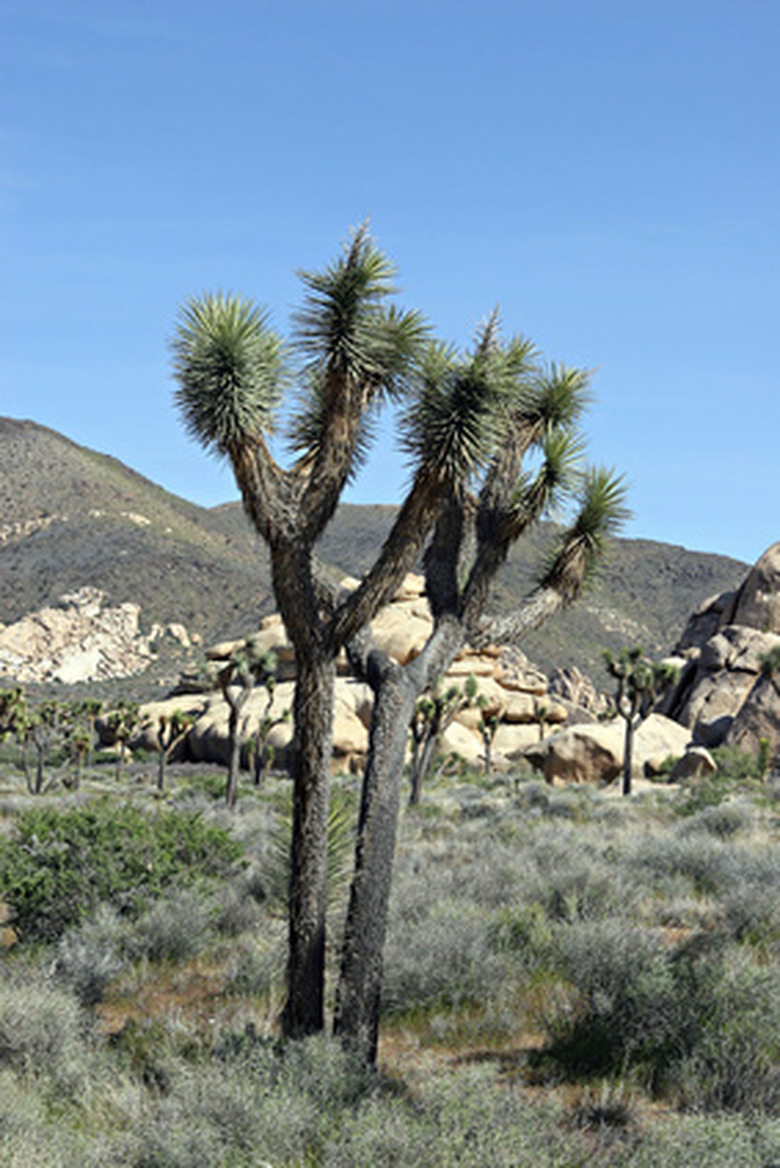Definition Of Desert Scrub
Desert scrub denotes a specific type of desert habitat. Sometimes called chaparral, desert scrub habitats cover parts of the North and South American west coasts, the western point of Australia, the area around Cape Town in South Africa, and the Mediterranean coast.
The desert scrub definition also applies to multiple species of plants found in the desert scrub habitat, such as creosote bush (Larrea tridentata), rabbit brush (Chrysothamnus viscidiflorus), and all the species of Encelia, Ambrosia and Coldenia, among others.
Desert Scrub Definition and Formation
Desert Scrub Definition and Formation
Four geographic conditions cause the formation of a desert. In the subtropics, (near 30 degrees latitude) air from the upper atmosphere causes more evaporation than precipitation, giving rise to the Sahara and Australian deserts.
On the west coasts of continents, between 20 and 30 degrees latitude, easterly winds prevent moist air from reaching the coast. Some moisture condenses into fog at the coast, creating "fog deserts" like Baja California and the Western Sahara.
When clouds run into the mountains, the air movement creates a rainshadow behind the range that gets less precipitation than evaporation. Rainshadow deserts include Death Valley, California and the Peruvian Desert. The middle of a continent, protected from moist ocean air, often consists of drier climates such as the Great Basin desert in the United States.
Habitat Adaptation
Habitat Adaptation
Desert scrub habitats adapt and grow back in stages to survive environmental disturbances. Such disturbances can include fire, excess moisture, drought and human development. Habitats rebuild themselves in stages, often over the course of decades or centuries.
The survival of new seedlings depends on moisture levels, but the persistence of many plant types is not well known due to the varied duration of each rebuilding stage.
Soil Conditions
Soil Conditions
Valley floors and lower bajadas (lower slopes of mountains with loose soil) form the perfect location for desert scrub. Well-drained course soil ranges in salt content from low to high; the calcium carbonate forms a caliche hardpan or subsurface under the top layer of soil.
Scrub brush size relates directly to soil depth, and shallow soil on top of a salt pan perfectly suits desert scrub plant life.
Desert Scrub Climate
Desert Scrub Climate
In winter, cool temperatures range from 14 to 43 degrees Fahrenheit with the lowest temperatures occurring in January. Summers reach their hottest in July sometimes reaching up to and above 117 degrees Fahrenheit.
Rainfall is slight by the desert scrub definition: anywhere from one to 12 inches of rain may fall in desert scrub areas annually.
Common Desert Scrub Vegetation and Desert Biome Plants
Common Desert Scrub Vegetation and Desert Biome Plants
Desert scrub gets its name from the drought resistant shrubs that grow over the ground. These desert biome plants grow close together and are characterized by their drought tolerance.
In drought conditions the spaces between the shrubs is bare. Evergreen scrub oaks may stick out of the densely packed shrubs, which are often so close together that large animals and humans cannot get through.
Only desert biome plants like pines, cork and olive trees can survive among the scrub during drought because of their hard leaves, and in some cases hairy leaves that collect moisture out of the air.
Additional Plant Life
Additional Plant Life
Other desert scrub plant life includes phreatophytes, succulents and ephemerals. Phreatophytes are plants with long taproots that dig 20 to 30 feet down to find groundwater supplies.
Succulents store water during rainy periods for use during dry spells. Ephemerals survive as full plants in the environment for only two to three weeks, after a rainfall, but live for years as seeds in a waterproof coating.
Cite This Article
MLA
Griffin, Dana. "Definition Of Desert Scrub" sciencing.com, https://www.sciencing.com/definition-desert-scrub-6556203/. 22 November 2019.
APA
Griffin, Dana. (2019, November 22). Definition Of Desert Scrub. sciencing.com. Retrieved from https://www.sciencing.com/definition-desert-scrub-6556203/
Chicago
Griffin, Dana. Definition Of Desert Scrub last modified March 24, 2022. https://www.sciencing.com/definition-desert-scrub-6556203/
